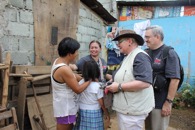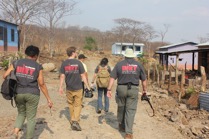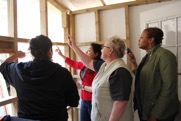Informal Settlers and Disasters
Overview and Background
Principal: DillingParticipants: Samples, Cuadra, Brower, Merrick
More than a billion people live in marginal and informal settlements, many without access to basic services, and very frequently in high-risk areas. Their vulnerability to disaster events is often compounded by a lack of infrastructure, environmental degradation, and increasing challenges exacerbated by climate change and sea level rise. If there is so much technology for prediction and prevention, why do governments/donors continue to struggle with losses in the same communities, disaster after disaster? Evidence in the scientific community leads us to believe the answer to this question lies in the process of how human settlements are established and the underlying factors that encourage the population within those communities to establish in high risk areas.
Traditionally, this problem has been addressed by trying to relocate or upgrade the high risk communities. However, efforts to implement relocation and upgrade projects without multi-stakeholder participation and evaluation of complex social, economic and cultural factors that create and sustain such settlements often results in failure- the resistance of the population. This leads to a waste of government and donor resources and time with little to no significant improvement on the problem.
Over the course of three field research trips to the Philippines and Chile, one of our faculty/staff research teams (Dr. Cuadra, Dr. Dilling, and Ms. Samples, along with Dr. Brower from PA on two of the trips) delved into the benefits and dilemmas encountered during implementation of relocation and upgrade programs designed to safeguard informal settlements from natural phenomena. Their research effort was specifically focused on the social, cultural and economic reasons that influence informal settlers’ resistance, mistrust and ultimate abandonment of relocation sites and withdrawal from upgrade projects. The work included collection and analysis of qualitative data from in depth community and government/donor interviews, focus groups, archival research and field observations. Their findings have been presented and published in a number of venues, as seen at the bottom of this page.
Philippines 2013
Case Study: Quezón city, Bulacán and Cavite
Location: Philippines
Event: Typhoon Ondoy 2011
Affected: 80 families
Relocated families: 42
Case Interviewed: 12 (4 M 8F )
 Informal, marginal settlements in the developing world are not only increasing but worsening in the face of overpopulation, economic instability and unprecedented climate variance. In the Philippines, cities are powerful magnets for rural populations lacking local opportunities and who seek to achieve prosperity for their immediate and future generations. These centers of “possibilities” however fail to provide basic needs and services for increasing numbers of internal immigrants. UN Habitat reports that as of 2012, at least 63% of the 92 million Filipinos live in urban centers such as Metro Manila, or what is officially called the National Capital Region (NCR). An estimated 3.1 million of them lack secure land tenure and 2.7 are informal settlers living in slums (Karaos, Nicolas, Rabacal et al, 2012). The Philippines, like many island countries, suffers from land deficit; housing is not only difficult but economically unfeasible for the urban poor. Thus, the urban poor are unconsciously driven to areas otherwise unsuitable for housing. These danger zones are prone to flooding, seismic activity and landslides. Living in these areas exposes informal settlers to a vicious repeat cycle of destruction and loss of life. What is the source of a community’s resistance to relocate in the face of continuing risk? Some studies suggest that the place that we call home is not just a point in a geographical setting. Communities develop shared values and shared identity with place (Hewitt, K 1997). The Filipino government is currently on a crusade to address this problem by planning to relocate the individuals at high risk; they have certainly found opposition from the settlers. But, what are the specific factors that impede successful relocation? In this study we attempt to answer this question by looking at the cultural, social, economic, political factors and interactive dynamics that influence the way people decide where to live. The findings presented in this paper correspond to field work in the Rizal Province and its Municipality of San Mateo, more specifically concerning those living in Barangay Banaba. Hopefully the collection and analysis of such data could contribute towards a better understanding of the individual at risk, formulation of more effective disaster reduction strategies, and greater discussion of the situation and needs of these communities.
Informal, marginal settlements in the developing world are not only increasing but worsening in the face of overpopulation, economic instability and unprecedented climate variance. In the Philippines, cities are powerful magnets for rural populations lacking local opportunities and who seek to achieve prosperity for their immediate and future generations. These centers of “possibilities” however fail to provide basic needs and services for increasing numbers of internal immigrants. UN Habitat reports that as of 2012, at least 63% of the 92 million Filipinos live in urban centers such as Metro Manila, or what is officially called the National Capital Region (NCR). An estimated 3.1 million of them lack secure land tenure and 2.7 are informal settlers living in slums (Karaos, Nicolas, Rabacal et al, 2012). The Philippines, like many island countries, suffers from land deficit; housing is not only difficult but economically unfeasible for the urban poor. Thus, the urban poor are unconsciously driven to areas otherwise unsuitable for housing. These danger zones are prone to flooding, seismic activity and landslides. Living in these areas exposes informal settlers to a vicious repeat cycle of destruction and loss of life. What is the source of a community’s resistance to relocate in the face of continuing risk? Some studies suggest that the place that we call home is not just a point in a geographical setting. Communities develop shared values and shared identity with place (Hewitt, K 1997). The Filipino government is currently on a crusade to address this problem by planning to relocate the individuals at high risk; they have certainly found opposition from the settlers. But, what are the specific factors that impede successful relocation? In this study we attempt to answer this question by looking at the cultural, social, economic, political factors and interactive dynamics that influence the way people decide where to live. The findings presented in this paper correspond to field work in the Rizal Province and its Municipality of San Mateo, more specifically concerning those living in Barangay Banaba. Hopefully the collection and analysis of such data could contribute towards a better understanding of the individual at risk, formulation of more effective disaster reduction strategies, and greater discussion of the situation and needs of these communities.
Nicaragua 2013
Case Study: San Francisco Libre, Nicaragua
Location: Nicaragua
Event: Lake Managua Floods 2011
Affected: 3500 people
Time in shelters: 6 months
Project type: Relocation
Case Interviewed: 7 (2 M 5F )
 Multiple studies suggest how disaster risk in developing countries is exacerbated by a combination of conditions such as lack of affordable housing, hazardous locations, people’s vulnerability, government mismanagement and political agendas (Quarantelli, 2003; Jha et al., 2010, Viratkapan & Perera, 2006; Horwood & Phillips, 2007; Davidson et al., 2007; Cronin & Gunthrie, 2011; Satterthwaite, 2011). Although not a recent issue, governments and urban planners continue to struggle to find solutions for safe, adequate and affordable housing for the urban poor. New urban projects and legislation often have unintentionally aggravated these communities’ situations (Sanderson, 2000). This pressure to solve the low income settler “problem” becomes even more poignant in the face of disaster and multiple fatalities.
Multiple studies suggest how disaster risk in developing countries is exacerbated by a combination of conditions such as lack of affordable housing, hazardous locations, people’s vulnerability, government mismanagement and political agendas (Quarantelli, 2003; Jha et al., 2010, Viratkapan & Perera, 2006; Horwood & Phillips, 2007; Davidson et al., 2007; Cronin & Gunthrie, 2011; Satterthwaite, 2011). Although not a recent issue, governments and urban planners continue to struggle to find solutions for safe, adequate and affordable housing for the urban poor. New urban projects and legislation often have unintentionally aggravated these communities’ situations (Sanderson, 2000). This pressure to solve the low income settler “problem” becomes even more poignant in the face of disaster and multiple fatalities.
A well-known approach to low income communities living in high risk areas is relocation either before or after a disaster event; according to Jha et al. (2010) relocation remains one of the most common project endeavors in post-disaster recovery. In San Francisco Libre, a community by Lake Managua in Nicaragua, the local government has undertaken a massive relocation project since the 2011 floods that left several coastal families without homes. In this study, we describe the current conditions and challenges for the relocated families and provide discussion about efforts by local government officials to provide much needed services on reduced budgets. This research benefits from field observations and interviews with government officials and families from the affected communities. Horwood and Phillips (2007) observes that in developing countries like Nicaragua, relocation projects do not succeed due to the rigid small design of relocation housing as well as lack of appropriate land and services. Knowledge about relocation practices and outcomes can help inform current practice and improve project development to provide effectively for low income families in developing countries.
Chile 2015
Case Study: Dichato
Location: Chile
Event: 2010 Bio Bio Earthquake and Tsunami
Case Interviewed:
Local people: 6 families
Government Officials: 12
NGOs and others: 3
 The mid-20th century framework of governmental responsibility for addressing disasters is sustained as governments pursue preparedness, response, recovery and mitigation actions at differing levels of effectiveness and in the face of increasing natural and man-made disasters around the globe. Scholars examining disaster management structures and social vulnerability in developing countries have indicated several factors which make some groups more prone to disasters than others: lack of affordable housing, hazardous locations, government mismanagement, political agendas, and marginalization of at-risk populations (Cannon, 1994; Quarantelli, 2003; Bankoff et al., 2004; Viratkapan & Perera, 2006 ; Davidson et al., 2007; Horwood & Phillips, 2007; Cronin & Gunthrie, 2011; Jha et al., 2010; Satterthwaite, 2011). In particular, emergency managers and urban planners within governments struggle to address the vulnerability of the urban poor in terms of secure, adequate and affordable housing. In well-documented cases, new legislation and policies have even exacerbated the living conditions of the poor (Sanderson, 2000). These conditions make the need to find a solution for those communities in high risk areas all the more urgent. This case study examines relocation as a governmental tool for the community of Dichato, Chile affected by the tsunami of 2010. Five years post-tsunami, a range of governmental mechanisms and community leadership activities including public-private partnerships, structural and non-structural mitigation initiatives, military response, NGO recovery activities, and stakeholder participation in planning efforts illustrate best practices and challenges for governments responsible for affected communities. These factors also distinguish the Dichato case from previous cases in Nicaragua and the Philippines.
The mid-20th century framework of governmental responsibility for addressing disasters is sustained as governments pursue preparedness, response, recovery and mitigation actions at differing levels of effectiveness and in the face of increasing natural and man-made disasters around the globe. Scholars examining disaster management structures and social vulnerability in developing countries have indicated several factors which make some groups more prone to disasters than others: lack of affordable housing, hazardous locations, government mismanagement, political agendas, and marginalization of at-risk populations (Cannon, 1994; Quarantelli, 2003; Bankoff et al., 2004; Viratkapan & Perera, 2006 ; Davidson et al., 2007; Horwood & Phillips, 2007; Cronin & Gunthrie, 2011; Jha et al., 2010; Satterthwaite, 2011). In particular, emergency managers and urban planners within governments struggle to address the vulnerability of the urban poor in terms of secure, adequate and affordable housing. In well-documented cases, new legislation and policies have even exacerbated the living conditions of the poor (Sanderson, 2000). These conditions make the need to find a solution for those communities in high risk areas all the more urgent. This case study examines relocation as a governmental tool for the community of Dichato, Chile affected by the tsunami of 2010. Five years post-tsunami, a range of governmental mechanisms and community leadership activities including public-private partnerships, structural and non-structural mitigation initiatives, military response, NGO recovery activities, and stakeholder participation in planning efforts illustrate best practices and challenges for governments responsible for affected communities. These factors also distinguish the Dichato case from previous cases in Nicaragua and the Philippines.
Related Publications and Presentations
Cuadra, J and Dilling, J. “Relocation of Disaster-prone Informal Settlements: Development Opportunity or Perpetuation of Poverty?” ACSP 2015, USA
Brower, R, Dilling, J, Cuadra, J. “Diverse Forms of Voluntary Action for Disaster Resilience: Evidence from the Philippines” ISTR-AP 2015 Japan
Cuadra, J, Dilling, J, Brower, R and Samples, M. “Current Relocation Practices Targeting Disaster Prone Communities in Developing Countries: Case Study San Francisco Libre, Nicaragua”. TIEMS Japan 2014. Published: Journal of Disaster Research Vol.10No.2: Special Issue 2015
Dilling, J, Brower, R, Cuadra, J, and Samples, M. “Informal Settlers, Government Officials, and Disaster Vulnerability: Experience from the Philippines” ICCEM 2014 Portugal. Keynote Presentation. Published: Journal of Safety and Crisis Management Vol 4 2014
Brower. Ralph S., Dilling, Janet, Magno, Francisco, A, Evolving and Implementing a New Disaster Management Paradigm: The Case of the Philippines, Book Chapter in Disasters and Development (Kapucu and Liou, eds). 2013
Dilling, Janet, Brower, Ralph, Cuadra, Judith, and Samples, Malaika. “The Dilemma of Informal Settlers in the Philippines” 2013 Conference on Crisis and Emergency Management, Cheongiu, Korea.
Dilling, Janet, Brower, Ralph, Cuadra, Judith, and Samples, Malaika. “Informal Settlers, Government Officials, and Disaster Vulnerability: Experience form the Philippines” Published: IREM Journal, Fall, 2013.
Brower, Ralph, Dilling, Janet, Cuadra, Judith, Obaid, Zia, and Samples, Malaika, “ NGOs as Brokers: Negotiating the Space Between High Risk Human Settlements and Government Relocation Policies”, ARNOVA 2013.
Cuadra, Judith, Samples, Malaika, Brower, Ralph, and Dilling, Janet, “Just and Safe Housing for Informal Settlers in the Developing World, 3rd International Conference on Disaster Management and Human Health, July 2013, A Coruna, Spain.
Dilling, Janet, Brower, Ralph, Cuadra, Judith, and Samples, Malaika, “Key Factors that Prolong High Risk Settlements”, Proceedings of the International Conference on Interdisciplinary Studies of Natural and Social Sciences, Beijing, P.R. China, December, 2012.
Cuadra, Judith, Brower, Ralph, Dilling, Janet, and Samples, Malaika, “High Risk Human Settlements: Tensions between Local Traditions and Government Policy”, Proceedings of the 2012 International Conference on Crisis and Emergency Management, Global Considerations of Crisis, Disasters, and Risk, Tallahassee, October 2012.
Brower, Ralph S., Dilling, Janet, and Magno, Francisco, A., “Mainstreaming Disaster Risk Reduction into Broader Development Goals in the Philippines”, Proceedings of the 2012 International Conference on Crisis and Emergency Management, Global Considerations of Crisis, Disasters, and Risk, Tallahassee, October 2012.